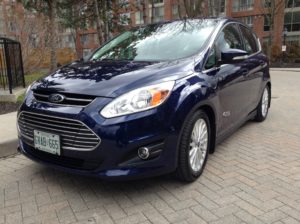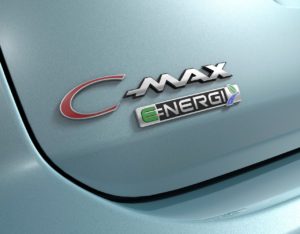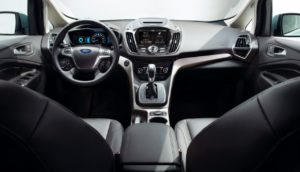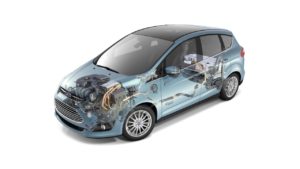Ask any teacher how best to help people learn, and they’ll often recommend you turn learning into a game. Makers of hybrid vehicles have taken note.
All things being equal, hybrid vehicles reduce fuel consumption over equivalent internal combustion engine- (ICE-) only vehicles. Drivers who want to achieve even better fuel economy need to learn how to drive more conservatively. To teach them, automakers are increasingly adding indicators to show them how they’re doing in real time.
Ford throws a few “gamification” tools into its 2016 C-MAX Energi. Drivers who accelerate and brake smoothly and take the other tips provided in Ford’s Quick Reference Guide will attain “high scores” that translate into miserly fuel consumption. I naturally gravitate to this game, and Ford seems to be betting other C-MAX buyers will too.

First impressions
The C-MAX doesn’t push the envelope design-wise. My Kona Blue Metallic tester was a tall four-door hatchback made to be slippery at speed and practical at all times.
Readily visible distinctions between regular C-MAX hybrids and their ENERGI cousins are the badging and the plug cover on the front driver-side quarter panel.

image courtesy Ford
Interior
The height of this vehicle makes it a comfortable fit for tall drivers. Everything’s where it needs to be. The shift lever juts out of the centre stack at a diagonal. Only the seat heater controls sit just below the shifter, on either side of a 12V outlet.

image courtesy Ford
Hockey bag test
The bag fits inside the trunk – just – without my needing to fold the rear seats down. The high-voltage lithium-ion battery raises the trunk floor about six inches above the bumper, so I can’t put the privacy cover over the bag. Regardless, it’s a great fit.

My tester included the optional power liftgate, which opens once the person bearing the key fob moves a foot underneath the rear bumper. Another gentle “kick” closes the liftgate.
In-car electronics
The three screens drivers use include the touchscreen in the centre stack as well as the two smaller screens in the instrument cluster.
Drivers choose the contents of those latter two screens, to the left and right of the speedometer, using corresponding five-way controls mounted on the left and right sides of the steering wheel.
- The left screen shows status information about how the car is driven, including an ever-present gas gauge.
- The right screen corresponds to features more fully shown on the touchscreen (entertainment, phone, navigation) as well as the efficiency leaves.
Ford has offered this logical layout for years in various vehicles, and it makes so much sense I hope Ford sticks to it for years to come.
Ford’s SYNC 3 system, with its improved interface, graces the interior of the C-MAX.
Unlike other SYNC systems, this one has five icons instead of six along the bottom of the touch screen. The missing icon? Climate control. Don’t worry – you won’t freeze or swelter in this car. Ford offers physical controls – buttons, dials, switches and a separate LCD screen – for heating, A/C, defrost and heated seats. The button labels are a bit tiny and some are obscured by the shift lever, but I prefer physical climate controls rather than touchscreen-based ones. They ought to join the ranks of controls that always seem to be included as dials or buttons (like audio volume and track-skipping).
Ford’s next-generation Smartguage with Ecoguide helps turn the impulse to burn less fuel into a game. Drive efficiently and the “brake coach” rewards you with higher percentages of energy captured from braking in the left instrument cluster screen, while the right screen display grows lush leaves. The more efficiently the C-MAX is driven, the more leaves appear here.
The touchscreen-based Power Flow Status app shows when power flows from the gas engine to the wheels and to the battery. It added to my gamification experience. I strove to keep this line “inactive” while the lines between the wheels and the battery shimmered. Aside from my typical lengthy braking approaches and non-jackrabbit starts:
- I coasted down hills, watching the battery recharge when I took my foot off the accelerator.
- Coasting at highway speeds after a burst of acceleration involving the gas motor, I sometimes coaxed the battery to take over entirely for a stretch.
The touchscreen drives the optional premium audio and navigation packages and shows what the rear view camera sees when the vehicle is in reverse. The car beeps at you when the optional Reverse Sensing System detects any objects that are too close for the C-MAX’s comfort.
SYNC 3 enables a variety of other features. Both Ford’s voice recognition and Apple’s Siri Eyes-Free work in this system. It might be time for Ford to partner with Apple and open-source its voice-driven features to the smartphone giant. (Google’s Android Auto is the other obvious partner here.) Ford’s voice recognition system could serve the diminishing percentage of drivers who don’t own smartphones. Everybody else would learn just the one system instead of trying to learn Ford’s as well as their phone’s.
Car systems occasionally need updates, the software equivalent of recalls and free upgrades rolled into one. The C-MAX Energi gets them when the vehicle is in range of a Wi-Fi connection.
Driving
The C-MAX sports two motors: a 2.0-liter Atkinson-cycle I-4 engine and an electric motor. Together, they produce 188 combined horsepower and 129 lb.-ft. torque.

Motors up front, battery in back. image courtesy Ford
The continuously variable transmission (CVT) transmits the power the driver wants to the wheels. Need acceleration? Step on it and both the gas and electric motors drive the wheels. The electric motor provides instant torque for a quick start, giving the gas engine and CVT time to adjust and push the car even harder. Passing power proved adequate in each situation I encountered.
Drive it more conservatively and the C-MAX does what it does best: conserve fuel. For the first few days in town, I didn’t make a dent in the gas gauge’s FULL reading.
A button on the side of the shift lever activates grade assist. It controls the C-MAX’s speed down grades, using regenerative braking to top up the battery as it does so.
Fuel efficiency
The C-MAX’s 53-litre fuel tank didn’t get overly drained thanks to the high-voltage battery system it also carries. (It helps that the fuel need only be regular unleaded 87 octane.) Ford publishes an EV range of 30 kilometers and a total range of 885 kilometres, thanks to how eager the battery system is to participate in every possible moment of motion.
Regenerative braking may be the most obvious arrow in a hybrid’s quiver, since the system tops up the battery each time drivers brake. Regenerative braking can put more than 90 percent of braking energy into the battery.
Ford throws in other fuel-maximizing features, many of which are also common on competitor hybrids, albeit often under different names.
- EV+ mode learns common destinations (like their homes) and switches the C-MAX to electric vehicle mode when drivers near them.
- Silent Key Start ensures the C-MAX runs on electricity only, at least until it starts to move. The engine only kicked in for me when I had to ascend my condo parking lot’s ramp up to grade.
- Automatic engine idle shutdown turns the vehicle off temporarily when the car idles for extended periods to prevent drivers from leaving the car silently running.
- The plug-in hybrid lets drivers top up the battery when the car is parked. Charge times can range from 2.5 to 7 hours, depending on the source you use for electricity. The C-MAX ships with a 120-volt convenience cord stowed in the floor compartment behind the driver’s seat. Drivers who want faster charging times need to check out Ford’s optional 240-volt charging system.
As the above features suggest, hybrids get worse mileage on the highway than they do on city streets, where slowing and regenerative braking happen more often. Drivers are likely to run the gas engine more than the electric one on long road trips. The C-MAX is no exception.
The MyFord mobile app and website enable plug-in hybrid drivers to find places to top up their batteries, lessening the hit on the gas engine. It also lets drivers remotely check charging status, schedule charging to optimize range, and otherwise make the C-MAX even more of a fuel miser.
Fuel could conceivably become stale and gum up the motor if drivers operate the C-MAX primarily in plug-in mode. This ordinarily happens in gas-powered lawn mowers or snowblowers that sit idle for months at a time. The occasional highway run ought to keep a hybrid’s fuel from going stale, since acceleration up to speed is difficult to do safely without the gas motor kicking in. Since some drivers can apparently take fuel efficient driving to ridiculous extremes, Ford added Fuel Freshness Mode to the C-MAX, so that the gas motor operate when fuel hasn’t run for a while.
For a city car, the C-MAX has a disappointing turning radius. U-turns on even generously wide streets often turn into three-point turns.
This doesn’t make the C-MAX difficult to parallel park. (Just in case, Ford offers Active Park Assist.) I was glad of the rear-view camera and sensors to tell me if any objects were behind me.
Pricing
The 2016 C-MAX Energi SEL starts at $31,999. My tester, with optional packages and various charges, lists at $38,329.